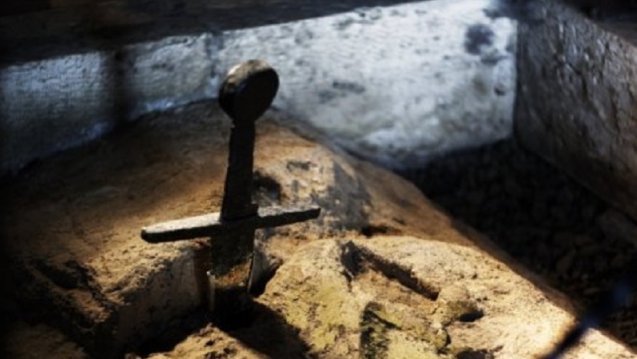Galgano Guidotti: the history
The story features Galgano Guidotti, a knight born in Chiusdino in about 1150, whose
aristocratic family was linked to the Bishop of Volterra, on whose behalf Guidotti was
aimed at defending and protecting interests, possessions and assets of the Chiusdinese
district.
Unlike you might think, Galgano was a violent young man and led a wild life, made of
amusements and pleasures, until the day that Archangel Micheal appeared to him in a
dream, to show him the right path and to make him a knight of God.

San Galgano: the conversion
From this moment on, Galgano began his conversion process, which culminated in a journey that led the young man on the hill of Montesiepi, where he knelt in reverence to Saint Michael and finally converted to Christianity.
Then, the knight stuck his sword into a rock, turning it into a cross, ending his past life and welcoming the beginning of the new one. The sword that was a symbol of death, became a symbol of peace and redemption, and the story of San Galgano became so popular that a small community of faithful made Montesiepi a pilgrimage destination, in order to talk to the saint and receive miracles and healings.
Galgano died on 30 November 1181, after living his last year as an hermit, in a hut built near the rock, and was found kneeling before the sword, in prayer.
Four years later, Pope Lucius III, following a direct commission from Cardinal Conrad of Wittelsbach, proclaimed him a saint.
The Hermitage and The Abbey
On the hill where San Galgano retired for life, between 1181 and 1185, was built a chapel that was the first tomb of the saint, in which center found place the rock pierced by the sword of the God’s knight: the Hermitage of Montesiepi.
About seventy years later, between 1220 and 1268, as a sign of devotion to the saint, the population built the first gothic church in Tuscany: the Abbey of San Galgano.
The latter lived a period of great splendor and welcomed important personalities until the middle of 1300, when famine, plague, looting and the practice of the Commenda marked the decadence of the building.
Fun fact: where's the roof?
A curiosity: this building is an open-air Abbey…practically: it has no roof.
The causes dictated by the sources are various: in one version, for example, it is said that a lightning struck the bell tower that collapsed on the roof; in another, it is said that the Commendatario Girolamo Vitelli, after having probably sold everything possible, even sold the lead roof.
However, according to the historians of the Academy of San Galgano, the reality is, unfortunately, much less picturesque. The roof of the Abbey, composed of wooden beams and bricks, collapsed due to the progressive weakening of the structures (repeatedly denounced over the years), which failed to support the collapse of the bell tower in 1786.
Instead, the metal roof (and not lead), was the Hermitage’s dome, not the Abbey’s, and was also not sold, but dismantled in 1154 by the government of the Republic of Siena, perhaps to make ammunition for the war against Florence, perhaps to prevent the Florentines from using it for the same purpose.
In short, just the good old Tuscan chauvinism!
In any case, the church was deconsecrated in 1789 and then abandoned.
Today (useful info)
Today, the complex of San Galgano is one of the most evocative in Italy and the Hermitage is still a consecrated church where Masses are celebrated weekly.
Both buildings are open from morning to evening, with extended hours for the summer months and, while the entrance to the Hermitage is free, to enter the Great Abbey you pay a small "gabella" (a medieval Italian word that stands for "ticket").
Finally, on summer evenings, it’s not uncommon to be able to attend beautiful concerts in the moonlight.
Ah! Last tip everybody: check the weather forecast before visiting, because….you know….no roof.
About the author
Written on 01/05/2021




Serena Biliotti
Once upon a time, in medieval England, there was a story which told that the one who would have managed to extract the legendary Excalibur would have become king. Actually, someone tried. And we’re not talking about King Arthur, but a normal tourist who, visiting the Hermitage of Montesiepi in Tuscany, attempted the arduous feat (without success and damaging the hilt, by the way).